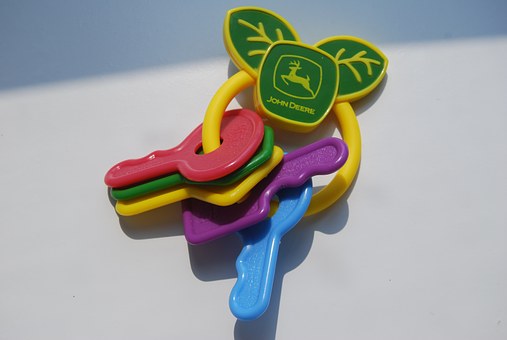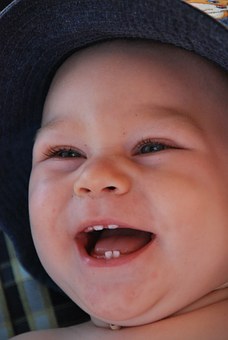Trying to cope with a teething baby is the most distressing thing a parent can go through. Quite a number of them have never known nor have no idea on how to help their babies go through this phase of their lives successfully.
If you ask any parent their views on teething, they will name it as the most frustrating period that a mother and a baby experiences.
On the other hand, every milestone witnessed brings some comfort no matter what it takes to pass that particular phase.
What is teething?
Teething is the process whereby the baby’s first teeth erupt through their gums. The medical term for teething is Odontiasis.
When does teething start?
I can vividly remember how beautiful my babies looked with their first teeth, especially when they smiled.
It’s a milestone to behold. Though their teething happened at different intervals on their months, it shows that each child is different and every step on their lives occurs differently.
As noted by dentists, some families have a pattern of early, average, and late teethers. When a baby is around 4 and seven months, you can notice the first tooth trying to push through the gum.
The first tooth usually erupts when the baby is at six months. The primary teeth are almost always the lower front teeth (lower central incisors).
It’s not a cause for alarm if you notice any difference in the months your babies start teething.
Most children have their primary teeth by their third birthday.
Signs and symptoms
I once randomly asked a few parents on the signs and symptoms they noticed when their babies started teething, and I can say the answers I got were quite the same.
Teething is usually associated with the discomfort of the gum and jaw as the tooth prepares to erupt.
As you look keenly on the surface of the gum tissue, you may notice that it’s a bit swollen and red.
Did you know that in some babies teething is painless?
Teething is uncomfortable, and if your babies experience some of the symptoms, it’s part of growth and a phase which passes after some time.
Being in a position to ease the irritability goes a long way.
Here are some of the symptoms;
• Extended drooling
• Irritability and crying
• Restlessness
• Change in eating and sleeping patterns
• Trying to bring hands or objects in their mouths
• Mild rash around the mouth because of excessive drooling
When the time reaches for the molars to erupt, they tend to rub the cheek or ear region.
Medications used to treat teething
Controversies and myths surrounding the use of pain relievers to curb the pain associated with teething have been all over.
Pain relievers, like acetaminophen or ibuprofen, help the baby a lot. You may give in a small dosage, but it is wise to consult the doctor first.
As much as you may want to help your baby to ease teething discomfort, it is advisable to seek the best opinion from the pediatric dentist.
Mothers go to extra lengths of administering funny tablets and gels to their babies without thinking of the implications there after.
Some use teething tablets, gels with benzocaine, homeopathic teething gels or tablets, or amber teething necklaces.
It’s crucial to do due diligence where your baby’s health matters.
Some teething tablets contain the plant poison belladonna and gels with benzocaine. The use of these two is to numb the baby’s pain.
The Food and Drug Administration (FDA) issued a warning in May 2011 against using oral medications that have benzocaine (such as Orajel).
Avoid over the counter tablets, sprays, and gels at all cost.
FDA warning tells of an association with Methemoglobinemia, which is a rare but severe acute complication.
This side effect hinders the red blood cells from transporting oxygen in the body.
A person who may have Methemoglobinemia becomes pale, confused, lightheaded, and has short of breath.
Also, avoid giving your child products that have Aspirin.
Amber teething necklaces are also prohibited. Why would anyone place a chain around their baby’s neck? The pendant can cause strangulation or chocking if the pieces accidentals break off. Avoid them.
Home remedies
Have you been looking for home remedies to help ease the discomfort in your baby? Then, here’s how;
When you apply pressure gently on the baby’s gum, they feel relieved; and because of this, doctors propose rubbing of a clean finger on the baby’s gum or allow them to bite off a clean washcloth.
Some teethers are made of rubber and are the best but make sure they remain clean. Avoid those that are liquid-filled as they may break and be risky health wise.
In case the pain interferes with the feeding, it is advisable to give the baby something to chew on; something bigger to avoid choking as this helps in easing the discomfort and improve on the food intake.
Alternatively, cold objects help in reducing inflammation.
Although frozen washcloths and ice cubes go a long way in helping in gum soothing avoid using them for long.
Placing things like teething biscuits in a child’s mouth is not advisable as it may choke him. Kindly note that whatever worked for you, may not work for others.

First dental appointment
Did you know that oral hygiene may start even before the first tooth of your baby erupts?
Dental care is very vital as the pediatric dentist ensures that the teeth develop normally. He gives you advice on proper hygiene.
Wiping your baby’s gum with a damp washcloth or brushing using a soft infant-sized toothbrush with water minus toothpaste is recommended.
Immediately the first tooth appears, you may use a toothbrush, water, and fluoridated toothpaste-small amount. Brushing can be done twice a day.
When a child reaches age three, they can spit while brushing you can add a little amount of toothpaste.
An overdose of fluoride is harmful, so as a parent, you need to monitor and direct your child as they brush.
Another way of taking care of your baby’s teeth is through flossing. Children learn fast by watching a grown up demonstrate something.
Teach them how to floss their teeth. It is always wise to consult your dentist on the oral hygiene of your child.

Myths on teething
Try to tell any mother against some myths they hold dearly, and all your talking will fall on deaf ears.
Ask any of them the most common symptoms of a child who is teething and fever, cough, diarrhea, cold, fussiness, and rashes all over the baby’s body will top the list.
The medical research has proved this wrong. That is, there is no connection between teething and the named myths on teething.
In case there are prolonged symptoms, it is good to consult a professional for further advice.
Finally
Always consult your pediatric dentist on matters regarding your baby’s oral hygiene. Taking care of their gums and teeth is very vital for the benefit of the child.
Once the first tooth erupts, that is from 6 months to one year; it is recommendable for the kids to see the dentist and for the parents to learn the preventative care.
Teething is a part of growth and may you help your baby to go through it with ease.







